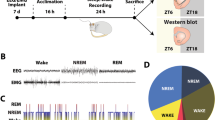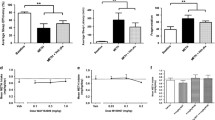Abstract
Rationale
Modafinil is currently used as a treatment for daytime sleepiness.
Objectives
The objectives of this study were to explore the dopamine transporter (DAT)-related effects of modafinil on behavior and in vivo neurochemistry in rhesus monkeys (Macaca mulatta).
Methods
The effects of modafinil (3.0–10 mg/kg, i.v.) were evaluated on locomotor activity, reinstatement of cocaine-maintained behavior, extracellular dopamine levels in the caudate nucleus, and DAT occupancy in the dorsal striatum. Eight subjects were fitted with a collar-mounted activity monitor to evaluate sleep-activity cycles, with 4 days of baseline recording preceding an injection of saline or modafinil (3.0–10 mg/kg). The effects of modafinil (3.0–10 mg/kg) and cocaine (0.3 mg/kg) on reinstatement of behavior that was previously maintained under a second-order schedule of i.v. cocaine delivery were tested in a separate group of subjects (n = 6). Finally, the effects of modafinil (3.0–10 mg/kg) on extracellular dopamine levels and DAT occupancy in vivo were characterized using microdialysis and positron emission tomography, respectively, in a within-subjects design (n = 4).
Results
Modafinil significantly increased nighttime locomotor activity and reinstated cocaine-maintained behavior but did not affect daytime locomotor activity. Modafinil significantly increased striatal extracellular dopamine levels at a dose that resulted in DAT occupancy of 64.4% (putamen) and 60.2% (caudate).
Conclusion
The behavioral and in vivo dopaminergic effects of modafinil are consistent with the profile of a low potency DAT inhibitor and may indicate potential for abuse at high doses.




Similar content being viewed by others
References
Anderson AL, Reid MS, Li SH, Holmes T, Shemanski L, Slee A et al (2009) Modafinil for the treatment of cocaine dependence. Drug Alcohol Depend 104:133–139
Ballon JS, Feifel D (2006) A systematic review of modafinil: potential clinical uses and mechanisms of action. J Clin Psych 67:554–566
Bernardi RE, Lewis JR, Lattal KM, Berger SP (2009) Modafinil reinstates a cocaine conditioned place preference following extinction in rats. Behav Brain Res 204:250–253
Bodenmann S, Xu S, Luhmann UF, Arand M, Berger W, Jung HH, Landolt HP (2009) Pharmacogenetics of modafinil after sleep loss: catechol-O-methyltransferase genotype modulates waking functions but not recovery sleep. Clin Pharmacol Ther 85:296–304
Castells X, Casas M, Vidal X, Bosch R, Roncero C, Ramos-Quiroga JA, Capellà D (2007) Efficacy of central nervous system stimulant treatment for cocaine dependence: a systematic review and meta-analysis of randomized controlled clinical trials. Addiction 102:1871–1887
Czoty PW, Justice JB Jr, Howell LL (2000) Cocaine-induced changes in extracellular dopamine determined by microdialysis in awake squirrel monkeys. Psychopharmacology 148:299–306
Czoty PW, Ginsburg BC, Howell LL (2002) Serotonergic attenuation of the reinforcing and neurochemical effects of cocaine in squirrel monkeys. J Pharmacol Exp Ther 300:831–837
Dackis CA, Lynch KG, Yu E, Samaha FF, Kampman KM, Cornish JW et al (2003) Modafinil and cocaine: a double-blind, placebo-controlled drug interaction study. Drug Alcohol Depend 70:29–37
Dackis CA, Kampman KM, Lynch KG, Pettinati HM, O'Brien CP (2005) A double-blind, placebo-controlled trial of modafinil for cocaine dependence. Neuropsychopharmacology 30:205–211
Deroche-Gamonet V, Darnaudéry M, Bruins-Slot L, Piat F, Le Moal M, Piazza PV (2002) Study of the addictive potential of modafinil in naive and cocaine-experienced rats. Psychopharmacology 161:387–395
Dutta AK, Zhang S, Kolhatkar R, Reith ME (2003) Dopamine transporter as target for drug development of cocaine dependence medications. Eur J Pharmacol 479:93–106
Gold LH, Balster RL (1996) Evaluation of the cocaine-like discriminative stimulus effects and reinforcing effects of modafinil. Psychopharmacology 126:286–292
Goodman MM, Kilts CD, Keil R, Shi B, Martarello L, Xing D, Votaw J, Ely TD, Lambert P, Owens MJ, Camp VM, Malveaux E, Hoffman JM (2000) 18F-labeled FECNT: a selective radioligand for PET imaging of brain dopamine transporters. Nucl Med Biol 27:1–12
Grimm JW, Hope BT, Wise RA, Shaham Y (2001) Neuroadaptation: incubation of cocaine craving after withdrawal. Nature 412:141–142
Hart CL, Haney M, Vosburg SK, Rubin E, Foltin RW (2008) Smoked cocaine self-administration is decreased by modafinil. Neuropsychopharmacology 33:761–768
Hermant JF, Rambert FA, Duteil J (1991) Awakening properties of modafinil: effect on nocturnal activity in monkeys (Macaca mulatta) after acute and repeated administration. Psychopharmacology (Berl) 103:28–32
Howell LL, Kimmel HL (2008) Monoamine transporters and psychostimulant addiction. Biochem Pharmacol 75:196–217
Howell LL, Wilcox KM (2001a) The dopamine transporter and cocaine medication development: drug self-administration in nonhuman primates. J Pharmacol Exp Ther 298:1–6
Howell LL, Wilcox KM (2001b) Intravenous drug self-administration in nonhuman primates. In: Buccafusco JJ (ed) Methods of behavior analysis in neuroscience. CRC, Boca Raton, pp 91–110
Howell LL, Carroll FI, Votaw JR, Goodman MM, Kimmel HL (2007) Effects of combined dopamine and serotonin transporter inhibitors on cocaine self-administration in rhesus monkeys. J Pharmacol Exp Ther 320:757–765
Ito R, Dalley JW, Robbins TW, Everitt BJ (2002) Dopamine release in the dorsal striatum during cocaine-seeking behavior under the control of a drug-associated cue. J Neurosci 15:6247–6253
Jasinski DR (2000) An evaluation of the abuse potential of modafinil using methylphenidate as a reference. J Psychopharmacol 14:53–60
Katz JL, Higgins ST (2003) The validity of the reinstatement model of craving and relapse to drug use. Psychopharmacology 168:21–30
Kimmel HL, O'Connor JA, Carroll FI, Howell LL (2007) Faster onset and dopamine transporter selectivity predict stimulant and reinforcing effects of cocaine analogs in squirrel monkeys. Pharmacol Biochem Behav 86:45–54
Kimmel HL, Negus SS, Wilcox KM, Ewing SB, Stehouwer J, Goodman MM, Votaw JR, Mello NK, Carroll FI, Howell LL (2008) Relationship between rate of drug uptake in brain and behavioral pharmacology of monoamine transporter inhibitors in rhesus monkeys. Pharmacol Biochem Behav 90:453–462
Kirkland Henry P, Davis M, Howell LL (2009) Effects of cocaine self-administration history under limited and extended access conditions on in vivo striatal dopamine neurochemistry and acoustic startle in rhesus monkeys. Psychopharmacology 205:237–247
Lindsey KP, Wilcox KM, Votaw JR, Goodman MM, Plisson C, Carroll FI et al (2004) Effects of dopamine transporter inhibitors on cocaine self-administration in rhesus monkeys: relationship to transporter occupancy determined by positron emission tomography neuroimaging. J Pharmacol Exp Ther 309:959–969
Madras BK, Xie Z, Lin Z, Jassen A, Panas H, Lynch L et al (2006) Modafinil occupies dopamine and norepinephrine transporters in vivo and modulates the transporters and trace amine activity in vitro. Pharmacol Exp Ther 319:561–569
Mann TM, Williams KE, Pearce PC, Scott EA (2005) A novel method for activity monitoring in small non-human primates. Lab Anim 39:169–177
McCabe SE, Knight JR, Teter CJ, Wechsler H (2005) Non-medical use of prescription stimulants among US college students: prevalence and correlates from a national survey. Addiction 100:96–106, Erratum in: Addiction 100:573
Minzenberg MJ, Carter CS (2008) Modafinil: a review of neurochemical actions and effects on cognition. Neuropsychopharmacology 33:1477–502
Myrick H, Malcolm R, Taylor B, LaRowe S (2004) Modafinil: preclinical, clinical, and post-marketing surveillance—a review of abuse liability issues. Ann Clin Psych 16:101–109
Newman JL, Beardsley PM (2006) Effects of memantine, haloperidol, and cocaine on primary and conditioned reinforcement associated with cocaine in rhesus monkeys. Psychopharmacology 185:142–149
O'Brien CP, Dackis CA, Kampman K (2006) Does modafinil produce euphoria? Am J Psychiatry 163:1109
Ritz MC, Kuhar MJ (1989) Relationship between self-administration of amphetamine and monoamine receptors in brain: comparison with cocaine. J Pharmacol Exp Ther 248:1010–1017
Shaham Y, Shalev U, Lu L, de Wit H, Stewart J (2003) The reinstatement model of drug relapse: history, methodology and major findings. Psychopharmacology 168:3–20
Stewart J, de Wit H (1987) Reinstatement of drug-taking behavior as a method of assessing incentive motivational properties of drugs. In: Bozarth MA (ed) Methods of assessing the reinforcing properties of abused drugs. Springer-Verlag, New York, pp 211–227
Stoops WW, Lile JA, Fillmore MT, Glaser PE, Rush CR (2005) Reinforcing effects of modafinil: influence of dose and behavioral demands following drug administration. Psychopharmacology 182:186–193
Turner DC, Robbins TW, Clark L, Aron AR, Dowson J, Sahakian BJ (2003) Cognitive enhancing effects of modafinil in healthy volunteers. Psychopharmacology 165:260–269
Volkow ND, Fowler JS, Logan J, Alexoff D, Zhu W, Telang F et al (2009) Effects of modafinil on dopamine and dopamine transporters in the male human brain: clinical implications. JAMA 301:1148–1154
Votaw JR, Howell LL, Martarello L, Hoffman JM, Kilts CD, Lindsey KP, Goodman MM (2002) Measurement of dopamine transporter occupancy for multiple injections of cocaine using a single injection of [F-18]FECNT. Synapse 44:203–210
Wilcox KM, Lindsey KP, Votaw JR, Goodman MM, Martarello L, Carroll FI, Howell LL (2002) Self-administration of cocaine and the cocaine analog RTI-113: relationship to dopamine transporter occupancy determined by PET neuroimaging in rhesus monkeys. Synapse 43:78–85
Wilcox KM, Kimmel HL, Lindsey KP, Votaw JR, Goodman MM, Howell LL (2005) In vivo comparison of the reinforcing and dopamine transporter effects of local anesthetics in rhesus monkeys. Synapse 58:220–228
Zolkowska D, Jain R, Rothman RB, Partilla JS, Roth BL, Setola V et al (2009) Evidence for the involvement of dopamine transporters in behavioral stimulant effects of modafinil. J Pharmacol Exp Ther 329:738–746
Acknowledgments
The authors express their gratitude to Lisa Neidert and Juliet Brown for capable technical assistance; Jon Nye and John Votaw for the help with PET analysis. We also thank Paul Chen for his aid in the conduct of the imaging procedures. The research was supported by USPHS Grants DA10344 (LLH), DA00517 (LLH), RR00165 (Yerkes National Primate Research Center), and Associacao Fundo de Incentivo a Psicofarmacologia (AFIP), FAPESP (98/14303) and CNPq (MLA, ST).
Conflict of interest
The authors declared no conflict of interest.
Author information
Authors and Affiliations
Corresponding author
Rights and permissions
About this article
Cite this article
Andersen, M.L., Kessler, E., Murnane, K.S. et al. Dopamine transporter-related effects of modafinil in rhesus monkeys. Psychopharmacology 210, 439–448 (2010). https://doi.org/10.1007/s00213-010-1839-2
Received:
Accepted:
Published:
Issue Date:
DOI: https://doi.org/10.1007/s00213-010-1839-2




